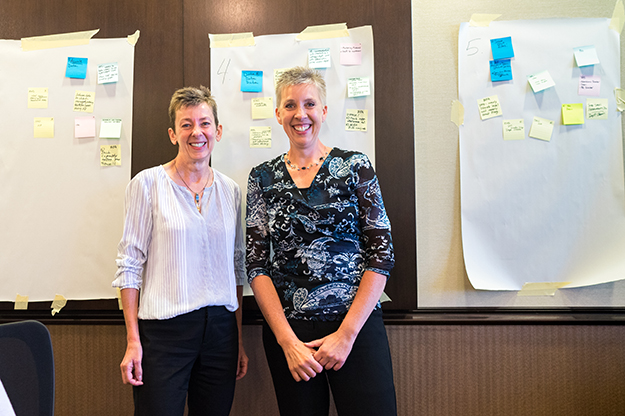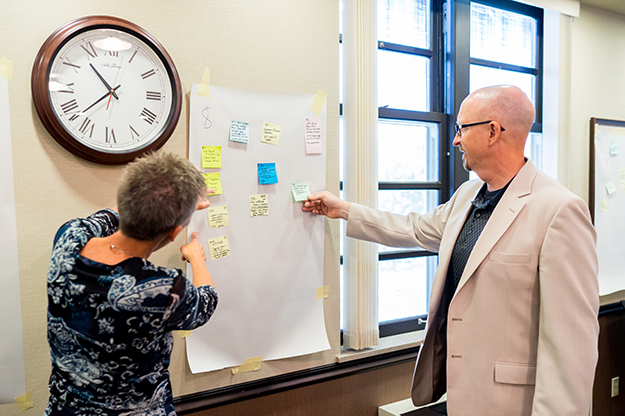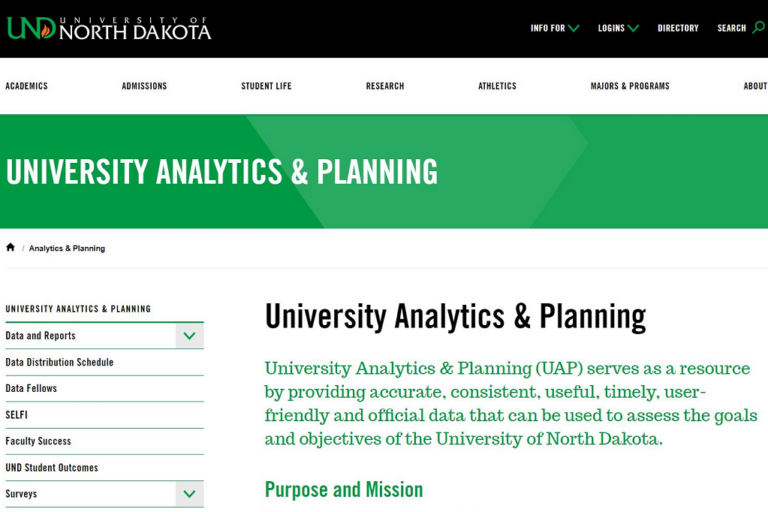A strategic road map
Process mapping provides the way forward in implementing the One UND Strategic Plan

The road to change just may start with sticky notes.
Sticky notes are the starting point for process mapping, which several areas are using as a tool to begin implementing the Strategic Plan.
“Process mapping helps navigate through complex tasks and challenges,” said Margot McGimpsey, who has used process mapping to develop and implement plans in the corporate world and recently conducted training on campus.
“As we gear up to implement the Strategic Plan, we need to know where we are now, and how we need to design our work flow to make progress on implementation,” said McGimpsey, who serves as special projects assistant to the provost. “We need to understand how work flows throughout the University.”
Real-life examples
Process mapping is a planning tool that visually describes workflow using a series of charts to diagram a process and how it can be improved.
Lisa Burger, assistant vice president for student academic services, received training on process mapping through a grant from Educause. She and the Strategic Enrollment Management group used it to look at how UND engages students, from admission and orientation all the way through graduation.
It all starts with sticky notes.
The group used 12 large easels – one for each month – and color-coded sticky notes to track each communication with students from orientation through graduation.
“It was kind of fun,” said Burger.
The easels told the tale. Some months were covered with sticky notes, while others were nearly blank.
The sticky notes were later converted to a process map that diagrammed steps so participants could see ways to improve student communication.
“We found that UND does a nice job of communicating with students throughout the year,” said Burger. “But there are gaps: We communicate with students more at the beginning and end of the semester than in the middle.”
Burger’s takeaway? “We need to ramp it up,” she said, “and identify goals and meaningful interventions to help students.” She added that the use of Starfish, an advising and student success tool on campus, is providing a new avenue to connect with students. “There are lots of ways to help students stay on track and graduate in four years. Finding those ways is fun.”

Leadership signs on
UND leadership is also signing on to process mapping, and the Academic Affairs Executive Leadership Group attended training led by McGimpsey.
“Process mapping requires us to think differently and make it possible to move toward the strategic goals represented by One UND,” McGimpsey said.
Jeff Holm, chair and professor of psychology and project manager for the Strategic Plan goal to deliver more educational opportunities online and on campus, plans to use the practice to help his project team and the campus at large better understand all the activities involved in the recruitment, admissions, and student success for online students.
“We operate in ways that are appropriate for our current goals. But implementing our plan for growing digital learning at UND may require us to operate differently,” Holm said. “Process mapping will help us think about how to be more efficient and how to choose the most appropriate pathways for growing online. They will also help us decide whether we need to choose different paths as circumstances change during our plan implementation.”
Lynette Krenelka, Director of Extending Learning, a member of Holm’s team who has fostered organic growth of UND online programs, agrees. “To prepare for the scale of growth we anticipate, we will be charting how we do things today to shape how we’ll do things tomorrow.”
Helping students succeed
The College of Arts & Sciences pulled together a team of faculty advisors and representatives from college offices, the registrar’s office and Essential Studies. They used process mapping to examine degree clearing, which ensures that students have completed all graduation requirements.
It resulted in changes to advising as well as increased use of Starfish, said Karyn Plumm, associate dean for academic success.
“We created a more streamlined process to ensure that students can graduate,” said Plumm. “Process mapping let us streamline degree clearing and respond to student needs earlier. In the past, it was often too late to take action and help students take missing credits to graduate. I especially liked the teamwork that comes with this. Understanding the steps in the process from different perspectives is so helpful in completing the process well.”
Plumm added that the new process has helped five percent more students learn about missing credits earlier while saving the College weeks of effort compared to the paper-based process.
And UND Admissions has already made changes to its recruitment program based on what it saw from the process maps: the need for an earlier connection between prospective students and faculty. A pilot program launched earlier this year proved this early connection works. Students who receive phone calls from faculty members yielded more enrollments than those who did not.
“It’s a fun way of helping people think through the process,” Burger said. “People sometimes get stuck in the same-old, same-old. This is a new way of looking at things.”


